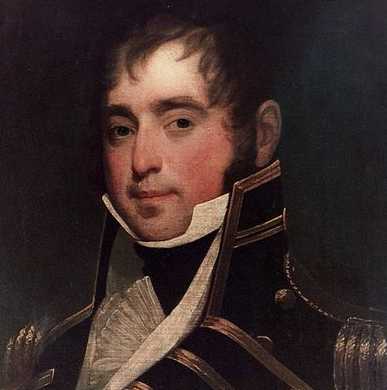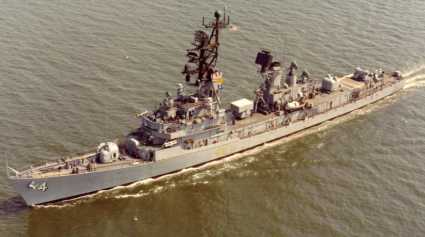Monday Maritime Matters
James Lawrence, born 10/1/1781, died 6/4/1813, at sea, after engaging with the enemy.

Arriving 5/18/1813 aboard USS CHESAPEAKE, Capt Lawrence found the ship in good order, but carrying an unlucky reputation. His orders were to clear to sea and go in search of British merchants in the Gulf of St Lawrence.
While making the final preparations to sail, the HMS Shannon (38 guns) sailed a few cables lengths from the Boston light house. The commanding officer, Captain Philip Broke, was largely unknown to the officers of the fledgling Navy, but the account from “Six Frigates” show Captain Broke to be a competent, disciplined officer, with a keen sense for what it takes to be ready for battle.
Having commanded Shannon for seven years, Brooke was one of the most experienced and efficient frigate captains in the British Service. In the post-Nelson, post-Trafalgar era of unquestioned naval supremacy, when the remnants of France’s Navy were mostly caged in harbors, and occasions of firing a shot in anger were few and far between , the Royal Navy’s overall standards of gunnery and readiness had declined [ed: sound familiar?]. The Shannon was an exception. Captain Broke was a zealous advocate of daily gun drills. In addition, when he had captured American merchants off Boston, he chose to burn them to the waterline, so as to not weaken his crew by having to send so many prize crews to man the captured vessels. He bypassed the fortunes that would have come to himself and his crew for the prize values, as he wanted the fight rather than the money.
[…]
Shannon was ready for battle as any frigate could ever have been, and Captain Broke wanted and opportunity to prove it.
[…]
To set the stage, Commodore Rodger’s squadron had sailed from Boston on the 1st of May, in a fog, in order to allude the British Squadron awaiting their departure from port. The best strategic role for the US Navy was to be commerce raiders, and not go broadside with the British Navy, not because of lack of courage, but because there were few ships on hand to send straight to battle.
Meanwhile, off Boston, Captain Broke prepared a gentlemanly challenge to Captain Lawrence, asking for a ship to ship duel, and would even ensure there was no interference from other British vessels in the area. He dispatched his letter ashore with an impressed American sailor, but it never reached Captain Lawrence. I highly recommend you read “Six Frigates” in order to follow the precursors to this famous battle about to unfold, which contains the complete text of the above mentioned letter/challenge.
While Captain Lawrence had seen his share of fighting at sea at various levels of the chain of command, he had only been aboard the ship for less than two weeks when he ordered the lines cast off and to sail, on the clear day on the 1st of June, out of Boston Harbor. He had not had any time to exercise with his new crew, nor them with him in any sort of battle drills for gunnery or maneuvering the ship. No the less, he set sails and departed the safety of the piers about noon, as the sails of the HMS Shannon were quite evidently awaiting the meeting. He knew there was the possibility of a fight in the offing, as he inspected the gun crews with LT George Budd and directed cannister, bar and grape shot also loaded on top of the ball shot in the gun barrels.
The two vessels closed. Captain Broke mustered his crew and said this:
Shannons, you know from various causes the Americans have lately triumphed on several occasions over the British Flag in our Frigates…they have said and they have published in their papers that the English have forgotten the way to fight. You will let them know today that there are Englishmen in Shannon who still know how to fight.
Don’t try to dismast her. Fire into her quarters; main-deck to main-deck; quarter-deck into the quarter-deck. Kill the men and the ship is yours…
[…]
Quietly they proceeded to their battle stations, as the Captain directed. By 5:45, the USS CHESAPEAKE was abeam the Shannon at a range of about 50 yards, upwind, and Captain Lawrence luffed his sails. Both crews had held their fire, even though opportunities had been presented at greater ranges to press an advantage. The firing began, not as two broadsides, but as guns found targets and marksmen in the tops picked of the exposed enemy sailors.
Within two minutes, the gore on the USS CHESAPEAKE was horrible, as the daily drills of the Shannon’s gunners took their toll. Captain Lawrence suffered two wounds, and of 150 men on the spar deck, 100 were killed or wounded, the rigging and sails severely damaged. While the Shannon’s crew was being killed or wounded as well, it was not the officers that were cut down in large numbers, as was the case on the American ship, so the command and control remained intact as the ship’s continued the battle. The USS CHESAPEAKE’s wheel was shot away and the rigging not in a condition to maneuver. The Marines sharpshooters had been shot off their perches by Shannon’s crew, who continued to shoot at the exposed crewmen of the CHESAPEAKE with accurate fire.
Captain Broke lead a boarding party onto the CHESAPEAKE when the ships came together, the confused state of affairs aboard the American vessel had the sailors running below decks for their lives in the face of a ferocious British crew, led by their Captain.
Captain Lawrence lay in the cockpit below, wounded, ordering his remaining officer to rally the crew, but that was to no avail. As the sailors ran below and past him, he yelled “Don’t give up the ship!” and “Fight her till she sinks!” and finally: “Don’t give up the ship. Blow her up!” No one followed his orders well enough to save the day.
From page 414 of “Six Frigates,” Ian makes this analysis:
It was a strange that these dying words, comprising and order (not obeyed) to commit mass suicide, were subsequently adopted as the Navy’s unofficial motto. They were not the kind of words that were spoken with posterity in mind; they were never intended to be quoted or even remembered. Don’t give up the ship! This was the final, despairing roar of a man who was bleeding to death, a man who had fought gallantly but ineffectually, losing a valuable ship to a 37 man boarding party in an action lasting less than fifteen minutes.
Captain Lawrence died of his wounds from the battle a few days later and was buried with full military honors in Halifax, Nova Scotia, with 6 British naval officers as his pall bearers.
Five ships have been named to honor Captain James Lawrence. The first was the brig serving as Oliver Perry’s flagship on Lake Erie, who was a close friend of James Lawrence and who immortalized the words of Captain Lawrence in our naval history. The second USS LAWRENCE was also a brig in the Navy from 1843 to 1846. DD-8, a 400 ton destroyer, was the third LAWRENCE and saw no significant combat action.
USS LAWRENCE (DD-250) served from 1920 to 1946, with duties as a school ship and coastal patrols along the west coast area.

The most recent USS LAWRENCE (DDG-4) of the CHARLES F ADAMS Class guided missile destroyer class commissioned in 1958 and was decommissioned in 1990. She was a participant in the naval blockade of Cuba in 1962. In 1972-73, LAWRENCE made a deployment to Vietnam to provide gunfire support to the ground forces.And so, some detail of the history of the beginnings of our Navy. The moral of the story? Just because there isn’t an enemy to provide you with the opportunity to practice the battle skills necessary to keep well trained doesn’t mean you shouldn’t work on them as best you can for the day that is coming. Captain Broke is an example to emulate.
Categories: History, Maritime Matters, Military, Military History, Navy
